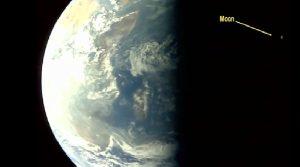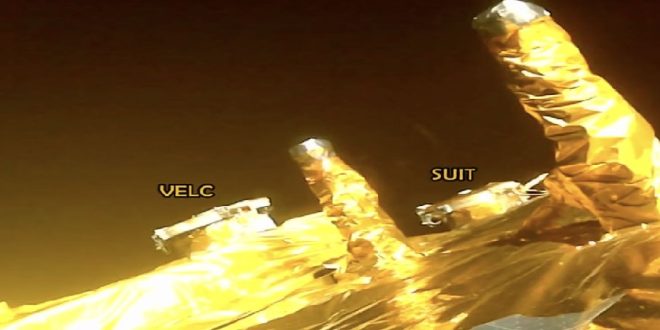08-09-2023
Bureau Report + Agencies
NEW DELHI: The Indian Space Research Organization (ISRO) has shared the first images sent by the country’s solar observation mission as it makes its way towards the Sun.
 Aditya-L1 lifted off on Saturday and is on a journey that will take it 1.5 million km (932,000 miles) from the Earth – 1% of the Earth-Sun distance.
Aditya-L1 lifted off on Saturday and is on a journey that will take it 1.5 million km (932,000 miles) from the Earth – 1% of the Earth-Sun distance.
It will take four months to reach its destination, ISRO says.
India’s maiden solar mission came just days after the country became the first to land near the Moon’s South Pole.
On Thursday morning, ISRO shared two photographs taken on 4 September by a camera mounted on Aditya-L1.
One of the images shows the Earth and the Moon in one frame while the Earth looms large, the Moon is a tiny speck in the distance. The second photograph is a “selfie” that shows two of the seven scientific instruments the solar mission is carrying.
India’s first space-based mission to study the solar system’s biggest object is named after Surya, the Hindu god of Sun who is also known as Aditya and L1 stands for Lagrange point 1 – the exact place between the Sun and Earth where the Indian spacecraft is heading.
According to the European Space Agency, a Lagrange point is a spot where the gravitational forces of two large objects – such as the Sun and the Earth, cancel each other out, allowing a spacecraft to “hover”.
 Once Aditya-L1 reaches this “parking spot”, it would be able to orbit the Sun at the same rate as the Earth. This means the satellite will require very little fuel to operate.
Once Aditya-L1 reaches this “parking spot”, it would be able to orbit the Sun at the same rate as the Earth. This means the satellite will require very little fuel to operate.
Since its launch on Saturday, Aditya-L1 has already completed two manoeuvres around the Earth. After going around the Earth three more times, it will be launched towards L1.
From this vantage position, it will be able to watch the Sun constantly and carry out scientific studies.
ISRO has not said how much the mission would cost, but reports in the Indian press put it at 3.78bn rupees ($46m; £36m).
The orbiter carries seven scientific instruments that will observe and study the solar corona (the outermost layer); the photosphere (the Sun’s surface or the part we see from the Earth) and the chromosphere (a thin layer of plasma that lies between the photosphere and the corona).
 Pressmediaofindia
Pressmediaofindia




